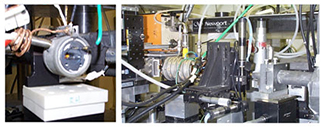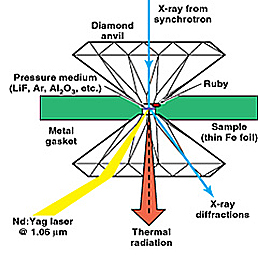Ohmic Heatings
Laser Heatings
Low Temperatures
Ohmic Heatings
Heating experiments at high pressure are extremely valuable in understanding fundamental physical and chemical behavior of materials as well as in examining phase stability and phase diagrams. Diamond anvil cell (DAC) experiments usually have been very productive at room temperature. In order to perform experiments at high temperature using a DAC, one has to develop a heating technique either using ohmic heating or optical lasers. Ohmic heating is relatively simple and the workable temperature can reach to 1000 K. We have tested various wire heating configurations coupled with DAC experiments.
Initially, we used a band heater to heat samples inside DACs to ~750 K. To aid thermal coupling between the heater and the cell body, we used aluminum filler. As the temperature goes up, the pressure starts decreasing largely due to the thermal expansion of the cell body. However, it stays stable once P and T are adjusted to the conditions of a measurement. We used a similar heating method to measure x-ray powder diffraction and Raman spectra. To reach higher temperatures, a simple wire heating method has been adapted. A Ni-Cr wire wound into a 4–5 mm diameter loop is placed around sample area covering the gasket and two diamond anvils. A small ceramic ring is cut and used to hold the heater wire in place. To prevent oxidation of the heating wire, the DAC with an external heater is placed in a vacuum jacket.
Laser Heatings
Various cw- and pulsed-lasers (YAG, YLF, CO2, and pulsed-YAG lasers) are used to heat the samples to a few thousand degrees at Mbar pressures in diamond-anvil cells. This technique is capable of generating the pressure-temperature conditions of the interiors of the Earth and Jovian planets, thermal and nuclear explosions, and metallic-hydrogen. These laser heating techniques are often coupled with synchrotron x-ray diffraction and laser spectroscopy to discover and characterize new materials and novel phases with advanced materials properties and determine high pressure materials properties in situ at high pressures and temperatures.
Low Temperatures
Operating high-pressure diamond anvil cells at cryogenic conditions permits us to load molecular fluids and perform studies including low temperature phases and phase transitions. The High Pressure Physics Group has several cryostats suited to low temperature work.
The simplest of these systems is a sealed vessel that can be cooled to an appropriate temperature for condensing and capturing molecular fluids such as nitrogen or methane. This permits us to load these fluids at extremely high purity in a sealed environment. This technique is limited to the temperature of liquid nitrogen, 77 K.
For low temperature optical studies, the High Pressure Physics Group has two continuous flow cryostats that can achieve temperatures of ~1.5 Kelvin, and several closed cycle refrigerators that can achieve temperatures of ~ 10 Kelvin. These cryostats have optical windows that permit the diamond anvil cell sample to be imaged and studied spectroscopically at low temperatures.






